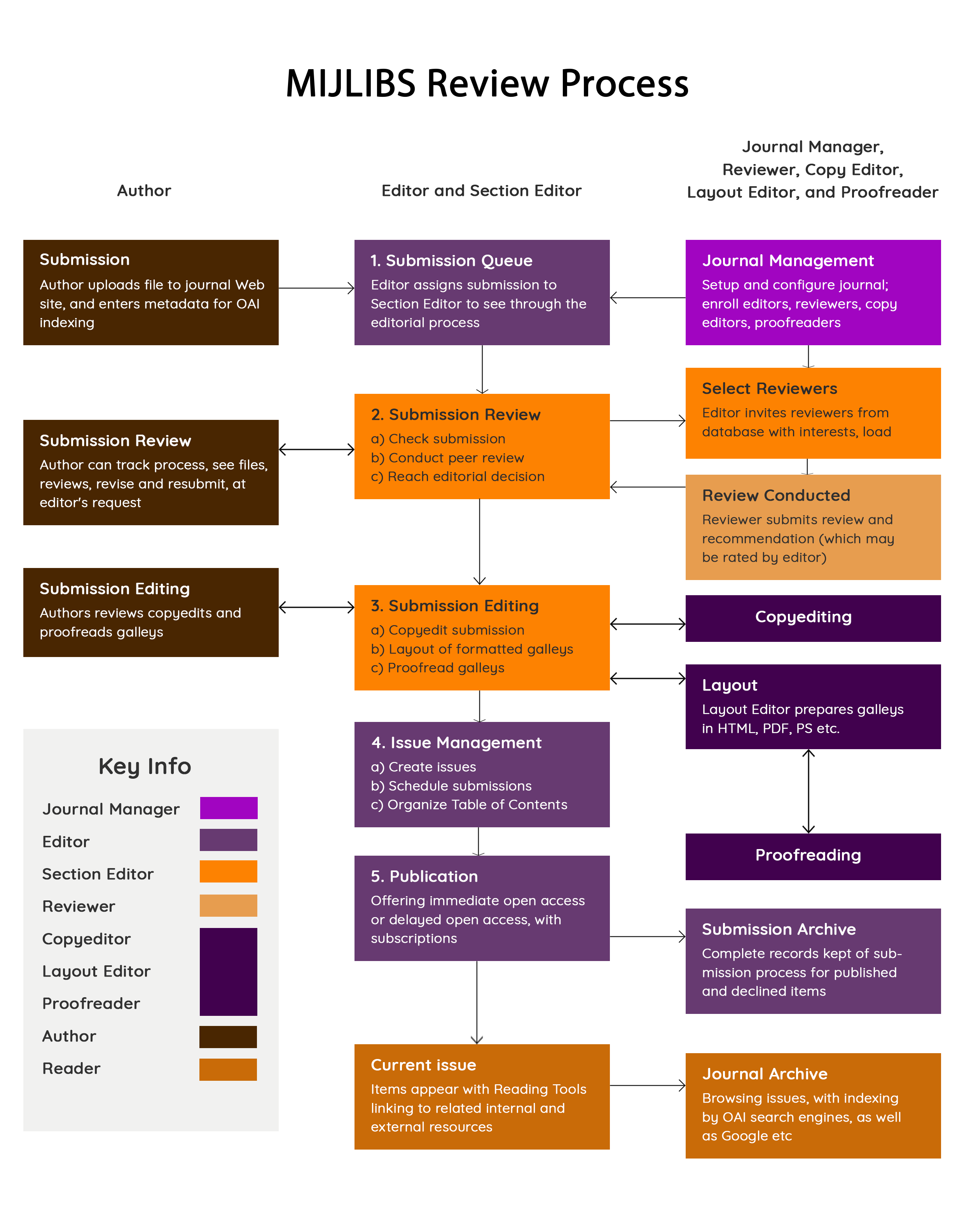CURRENT ISSUE

VOL 01 ISSUE 01 – JAN 2023
The practise of peer review is to ensure that only a good research paper is published. All manuscripts are following the procedure outlined below:
Initial Screening
MIJLIBS follows the policy of screening papers before sending them for peer review. In the initial screening, the manuscript is reviewed for plagiarism, and poor grammar, outside the aim and scope of the journal. If any paper fails to meet the general requirements, the paper can get rejected. This screening process takes 1-2 weeks and if these papers meet the minimum criteria, then they are passed on to two-three experts for further quality review.
Peer Review Policy
It is a process by which experts evaluate scholarly works and analyze the content. Its objective is to ensure and maintain the high-quality standards of our publishing house.
The Peer Review Policy works as another checkpoint to make sure that only good and original quality work is published. All submitted manuscripts are read by our Editorial Staff who are experienced in their fields. We select only those research papers that meet our standards and are sent for peer review and finally for publication.
Peer reviewers are ideally experts in their fields who are not part of the journal’s editorial staff. When a manuscript is submitted to MIJLIBS, a double-blind peer review process is followed to accomplish the basic requirements determined by our protocol.

Double-Blind Review
MIJLIBS follows the double-blind review process. In this process, the author and the reviewer are anonymous to each other. The peer-review process helps the publishing organization to select worthy research work for publication. In the peer-review process, the decision to publish a manuscript is the prerogative of a journal editor or the journal's editorial board.
In the broad spectrum, at first read-through reviewers will be assessing the author's argument construction, the clarity of the language and content. They question themselves for the following:
They may also consider the following:
Upon closer readings, the reviewer will be looking for any major issues:
The reviewer will also note minor issues that need to be corrected:
Possible outcomes of peer review
The journal’s editor or editorial board considers the feedback provided by the peer reviewers and uses this information to arrive at a decision. In addition to the comments received from the review, editors also base their decisions on:
Reviewers forward the review report to the Editor in chief, who will make a final decision to accept or reject the article. Once the Editor-in-Chief makes the decision on the manuscripts presented for review, the decision will be one of the following:
Once the manuscript is accepted for publication, we will send the Acceptance Letter, and publication copyright agreement to the author. After receiving the publication copyright agreement, we will forward the final proofread manuscript to the author for approval through email. At this point, the author can send some minor suggestions/corrections in terms of the formatting of the manuscript.
We will resend the proofread manuscript for final approval. Once the final approval is received back from the author, the manuscript will be sent for the final publication process.
If an author is asked to revise their manuscript and the author sends us an updated manuscript, it will be considered a new submission in terms of initial screening but the updated manuscript will be sent to the same reviewers to review again.
The Editor-in-Chief makes the final decision to reject the manuscript and conveys it to the author.
How long it takes to complete the review process?
MIJLIBS follows a policy of screening papers before sending them for peer review. In the initial screening, manuscripts get rejected because of plagiarism, poor grammar and being outside the aims and scope of the journal. MIJLIBS completes the initial screening of a manuscript within 1-2 weeks. Those manuscripts that meet the minimum criteria are normally passed on to two-three experts for review.
We send a manuscript for review to two-three reviewers simultaneously. Normally it takes 3-4 weeks to complete the review process. The average time from submission to publication is around 60 days.
CURRENT ISSUE

VOL 01 ISSUE 01 – JAN 2023
JOURNAL HIGHLIGHTS
Nature of Journal: Electronic
Subject Category: Library Science, Information Science, Information Resources Management, Information Retrieval, Knowledge Management, Library Administration, Research Methods, Instructional technologies and other related fields
Issue Frequency: Bi-Annual (2 issues Annually)
Special Issues: Summer Issue (Apr-May), Winter Issue (Oct-Nov)
Language Details: English
Article Processing Charge (APC): Free
Published by: Maayan Publications
Publication Guidelines: Follow COPE Guidelines
Open Access: Free Accessible for Readers
Review Process: Double Blind Peer Review
Time from Submission to Publication: 60 days, based on revision cycles
Email: editor@mijlib.com
JOIN US MIJLIBS!
Being on the editorial board or a reviewer of a journal is truly productive, pleasant and in fact prestigious which helps in add-on to the scientific world through the ways and guidelines given by experts in the relevant fields. Though it is time consuming and often goes unobserved, there are some important rewards that make the editorial board members/reviewers worthwhile.
© 2023, Maayan International Journal of Library and Information Science (MIJLIBS). Published by Maayan Publications.
